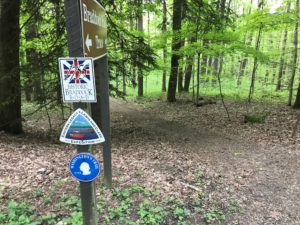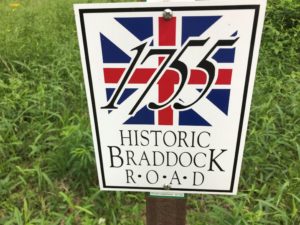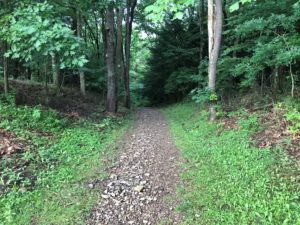
In my last history lesson I wrote about Braddock’s defeat at the Monogahela River near Pittsburgh. This battle was part of the French and Indian War. Today I am going to back up a little and begin talking about the history of the National Road. In order to talk about the National Road, I need to lay the groundwork by talking about Washington’s Trace and Braddock Road Trace.
When George Washington was first tasked with heading into the Ohio country and getting rid of the French, he had to find a way to get there. George Washington had an uncanny ability to know where he was in the wilderness, perhaps from his years as a surveyor. But Cumberland, Maryland, was the last developed outpost on the frontier in 1754. The road ended here. So, in order to get an army into the Ohio country to fight the French, Washington first had to build a road.
 The resulting Trace was a rough road that was cleared of large, old growth trees but not much else. Washington got the road “built” from Cumberland to close to current-day Brownsville, Pennsylvania. But the road was very rough and not really suitable for wagons or heavy artillery. It served the purpose of getting Washington’s army to the Great Meadows, and we know about his defeat there.
The resulting Trace was a rough road that was cleared of large, old growth trees but not much else. Washington got the road “built” from Cumberland to close to current-day Brownsville, Pennsylvania. But the road was very rough and not really suitable for wagons or heavy artillery. It served the purpose of getting Washington’s army to the Great Meadows, and we know about his defeat there.
The next year, 1755, General Braddock led his expedition toward Fort Duquesne at the forks of the Ohio. Because he was bringing heavy artillery, he set his army to expanding Washington’s Trace and making it twelve feet wide. When he got to the top of Chestnut Ridge, he continued north along the ridge instead of taking the pass Washington used. Because the road building was going so slowly, Braddock decided to divide his forces into a road building crew and another attack crew. We know that this attack crew was soundly defeated by the French and the Native Americans close to Fort Duquesne.

After the French and Indian War, settlers used the Braddock Road Trace to move into this area of western Pennsylvania. Today you can still walk along parts of Washington’s Trace and the Braddock Road Trace at Fort Necessity, Braddock’s Grave, and Jumonville Glen and Jumonville Camp and Retreat Center. Eventually this wilderness road would become the foundation for the National Road, but that is a history lesson for another day.
